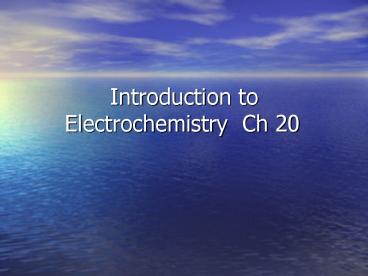Introduction to Electrochemistry Ch 20 - PowerPoint PPT Presentation
1 / 11
Title:
Introduction to Electrochemistry Ch 20
Description:
Oxidation and reduction always occur together ... Use bracketing lines to connect the changing atoms and write in the ox # change ... – PowerPoint PPT presentation
Number of Views:61
Avg rating:3.0/5.0
Title: Introduction to Electrochemistry Ch 20
1
Introduction to Electrochemistry Ch 20
2
Oxidation/Reduction
- Any reaction which involves a change in oxidation
numbers transfer of electrons from one substance
to another - Oxidation and reduction always occur together
- Historically Oxidation was the addition of
oxygen to a substance - Oxidation Loss of electrons
- Reduction Gain of electrons
- LEO the lion says GER or OIL RIG
- Not all reactions are redox. If there is no
change in ox numbers, they are not redox. Ex
acid/base reactions
3
Identifying Oxidation/Reduction
- Mg S ? Mg2 S-2
- Magnesium lost electrons Oxidized
- Sulfur gained electrons Reduced
- Mg ? Mg2 2e- Oxidation ½ reaction
- S 2e- ? S-2 Reduction ½ reaction
- Reducing Agent Substance that was oxidized
(Magnesium) - Oxidizing Agent Substance that was reduced
(Sulfur)
4
Practice with Covalent Compounds
- 2H2 O2 ? 2H2O
- Assign oxidation numbers to determine what is
oxidized and what is reduced. - Know the oxidation number rules on page 639!!!
5
Practice
- Silver nitrate reacts with copper to produce
copper (II) nitrate and silver. - What is oxidized and what is reduced?
- Write the ionic equation
- Write the oxidation ½ reaction
- Write the reduction ½ reaction
6
Balancing Redox Reactions
- Oxidation Change Method (Line Connect Method)
pg 647-649 - Start with the skeleton equation
- Assign oxidation numbers to all atoms
- Identify which are oxidized and which are reduced
- Use bracketing lines to connect the changing
atoms and write in the ox change - Make the total e- lost equal to total gained
- Assign coefficients and check for balancing.
Adjust water as needed
7
Examples
- Hydrogen sulfide reacts with nitric acid to
produce sulfuric acid, nitrogen dioxide, and water
8
Balancing Redox Reactions
- Half-Reaction Method pg 650-651
- Start with the skeleton equation
- Write the complete ionic equation and assign
oxidation numbers - Write separate ½ reactions (ignore spectator
ions) - Balance the atoms in the ½ reactions
9
Half-Reaction Method continued
- Balance other elements first, then balance
Oxygen and Hydrogen - If in acidic solution, use H2O and H
- If in basic solution, use OH- and H2O
- Balance charges by adding e-
- Make e- equal in both by multiplying each ½
reactions
10
Half-Reaction Method continued
- Add the balanced ½ reactions
- Add the spectator ions back in and balance the
equation (you may simplify back into a formula
equation from an ionic equation)
11
Practice Problem
- Hydrogen sulfide reacts with nitric acid to
produce sulfuric acid, nitrogen dioxide, an
water. - Some possibly helpful links
- http//www.chemguide.co.uk/inorganic/redox/equatio
ns.html - http//www.chemtutor.com/redox.htm






























